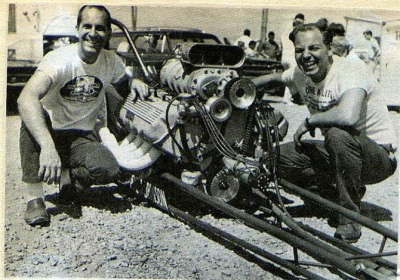An Ending and A Beginning
For both Pete Robinson and Bill Word the winds of change were blowing. In 1965 Pete would be moving into Top Fuel, with Ford assistance and the 427 SOHC engine. Bill Word’s family business responsibilities required him to also make a change, and he chose to drop out of the partnership. For both, drag racing had become much more than weekend fun. Pete’s component business was thriving and the move to Top Fuel meant focusing 100% of his time on racing and developing new products.
They parted ways amicably, and remained friends. Bill Word recalled that he and Pete agreed that Pete would buy Bill’s share of the team’s assets.
“Pete was moving to the SOHC Ford and Top Fuel. I knew he didn’t have the cash to buy out my part of the partnership, but I agreed to take payment when Pete could afford to pay me. We never did complete the deal, but I didn’t really mind. The years we raced together were great times. I wouldn’t trade them for any amount,” Bill remembered.
No longer involved in the daily grind of maintaining and running a race car, Word focused his attention on making William Word Antiques the major nameplate it is today in Atlanta. Now more than 50 years later, he has many great memories of what it was like to be on top in the drag racing world during the early 1960’s.
THE COMING OF THE ‘CAMMER
Once Pete decided to move from Top Gas to Top Fuel one key issue remained – engine choice. Small blocks, even ultra-light, could no longer compete. Tires and tracks had improved, and high horsepower became an advantage. In 1964 there was really only one feasible engine choice for blown fuel racing: the 392 Chrysler Hemi was the overwhelming choice for AA/Fuel. The 392 was a passenger car engine, but by ‘64 its fuel racing configuration had increased it to 1,000+ hp. It was sensitive to air/fuel ratios and ignition spark advance. A minor error could create detonation, cracked cylinder walls, or worse. “Worse” included main web failures that literally blew out the crank, rods, pistons and ten quarts of scalding, nitro-diluted oil! Milodon’s bottom-end girdle system helped, but real issues remained. A stronger engine was needed.
Chrysler had released the new and improved 426 Race Hemi in 1964. Although targeted for NASCAR, the new Hemi became an immediate success in Super Stock and FX. Only the Detroit-based Ramchargers had run the new 426 supercharged, on nitro. The new 426 Hemi was promising, but some issues remained.
At the same time in Dearborn Ford was releasing a new engine of its own, the 427 SOHC Ford (Single Overhead Camshaft) V-8. Like the 426 Hemi, it too had been designed for NASCAR. That changed when NASCAR suddenly outlawed both new engines. The concern was these new engines would make the top Grand National cars (now called Sprint Cup) too fast and too dangerous for superspeedways.
Both Chrysler and Ford turned to drag racing and unleashed their new engines.
Pete’s success with the Fairlane was viewed favorably by Ford’s racing group. His engineering background and serious approach to racing was key to receiving Ford factory support. Pete was tapped to develop the 427 SOHC as a blown fuel powerplant. There was much to be done.
‘Cammer engines were already making a mark, but normally aspirated engines did not create the horsepower or reliability issues associated with nitromethane/alcohol fuels and boosted manifold pressures.
 Pete and Connie Kalitta (right) pioneered SOHC 427 Ford in Top Fuel. Both shared data to cure ‘Cammer’s appetite for engine bearings. Here in 1965, posed with Pete’s car. Note minimal overspeed on blower (blower pulleys near same diameter). Both ran ‘Cammers with caution until oil system improvements were implemented. |
Robinson and his former Top Gas adversary, Connie Kalitta, were running the 427 SOHC Ford. Both were working primarily at resolving reliability problems, and once those issues were solved, the ‘Cammer’s enormous potential could be realized.
Kalitta had a new full-body dragster constructed by Ron and Gene Logghe’s Logghe Stamping Company. Pete had a new 156-inch wheelbase Woody Gilmore chassis, “Tinker Toy III”. Ever weight-conscious, Pete’s new car was clad in a magnesium half body without a nosepiece. Pete would soon put his ‘Cammer on a diet with aluminum or magnesium components.
Even with its cast iron heads and block, Pete’s new Woody car scaled at a mere 1,200 pounds. Eliminating another 150 or even 200 pounds via lightweight components could create a racecar of around 1,050 pounds, a decided advantage.


